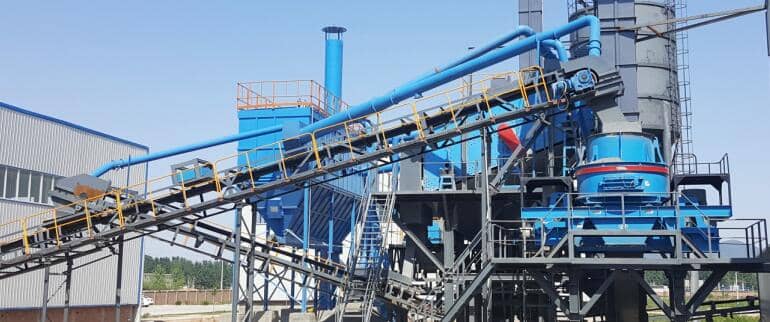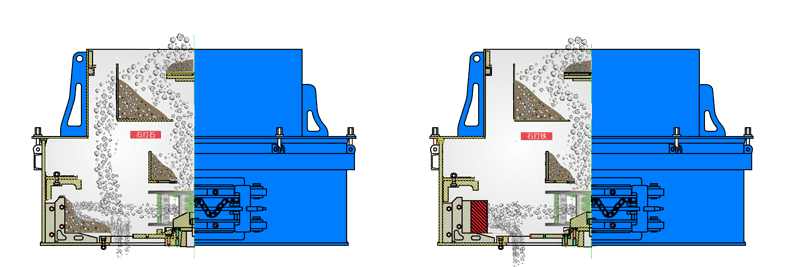What should We do with the Sand Making Machine Blocking Material?
author:dahua1 time:2019-09-03
With the increasing shortage of natural sand aggregates, the sand making industry market is in a stage of rapid development, and we will always encounter some minor problems when using sand making equipment in the sand making process. If we can solve it ourselves, then save a lot of time in our production process, without waiting for professional technicians to solve. Blocking is a problem we often encounter when using the equipment. To know how to solve it, we must first understand the reason for the blocking:

1. The amount of delivery to the inlet is too fast
Excessive amount of material conveyed from the front has not been broken, and it is followed by the subsequent conveyance, resulting in blockage under the inlet. In this case, the conveying amount and speed of the conveyor belt can be adjusted so that it can be matched with the crushing capacity of the sand making machine.
2. Raw materials are too large
The inlet of the sand making machine is generally less than 5 cm. If the raw material is about five or six centimeters, it may get stuck or even go down at the inlet. In this case, it may be necessary to add crushing equipment in front of the sand making to crush the material first.
3. There is no reasonable adjustment of the discharge opening
This is the same reason as the delivery volume of the inlet is too large. The material that has been broken is not delivered in time, and the subsequent material will be blocked in the crushing chamber. In this case, the outlet speed should be reasonably adjusted according to the capacity of the sand making machine.
4. The water content of the material is too high
When the material with higher water content is broken, it may have a certain viscosity. The small material after being crushed will be blocked between the crushing chamber and the wear-resistant member because of the viscosity sticking together, causing the material to be blocked. Therefore, when the moisture content of the material is too high, the material can be sieved and dehydrated before being crushed to solve the phenomenon of blocking.
5. The quality of the equipment itself is not guaranteed
Mistakes in the selection of the sand making machine will also cause blockage during the production process. Therefore, it is necessary to communicate with the technicians when purchasing, inform the technicians of the materials to be crushed, the size of the crush, etc., and select the appropriate machine model. Due to the fiery heat of the sand making industry, the sand making machine industry is also developing rapidly. Nowadays, there are many manufacturers of sand making machines on the market, and the output of the sand making machines is also uneven. Therefore, when selecting equipment, it is necessary to pay attention to it. Communicate with technicians in a timely manner to purchase a sand making machine that suits your needs.
6. Production line equipment coordination
For example, if the conveying capacity of the conveyor exceeds the crushing capacity, then when the conveying capacity of the conveyor does not match the crushing capacity of the crusher, the material is not broken, and the material behind it quickly enters the crusher, causing the crushing to not be blocked in time.
7. Wear and tear of wearing parts is serious
The serious wear of the sand machine itself is also one of the reasons for the blockage. Because the crushing material of the sand making machine mainly relies on the hammer head, and the hammer head is one of the wearing parts, if the hammer head is used for a long time, it is not replaced in time, and when the hard material is encountered, the hammer head cannot be completely broken, resulting in a large The block material cannot be completely broken, so that the material cannot be discharged in time, and when new materials enter, the blockage phenomenon will occur.
8. The voltage is too low
The unstable voltage will cause the feeding of the sand making machine to be uneven and discontinuous. If the feeding is not uniform, when the feeding speed is higher than the discharging speed, the crushing chamber and the discharge opening will form a blockage, and the broken product cannot be timely. Discharge and the material are continuously added to the equipment, which eventually causes the equipment to block the phenomenon. In severe cases, the equipment does not bear heavy load and stop.
9. The material is too hard or larger
When the material is too hard or the broken material particles are too large, and the strength of the sand making machine is not matched, the material is not broken, and the material behind it is forced into the interior of the crusher, resulting in the internal material not being discharged. There may be a blockage.

Sand machine blockage prevention measures:
1. When feeding, pay attention to the change of the ammeter pointer. Generally speaking, if the feed amount is too large, the current meter pointer has a large deflection angle, and if it is overloaded for a long time, the motor will be burned out. In this case, the door should be immediately reduced or closed, and the feeder can be added to control the amount of feed to prevent the sander from blocking.
2. Improper matching with the conveying equipment will result in weakening of the wind in the discharge pipe or blockage after no wind. Therefore, before designing the sand production line, it is necessary to avoid the mismatch between the equipments and prevent the blockage.
3. In the production of sand making machine, regularly replace broken and severely aged hammers, and regularly check the screen. If aging is found, the screen holes are closed, broken and replaced in time. The moisture content of the pulverized material should be less than 14%. These measures can reduce the blockage and improve the efficiency of the equipment.
Previous Article:Importance of Jaw Crusher in Stone Crushing Production Line
Next Article: Luoyang Dahua Attends Mining and Metal Central Asia 2019


